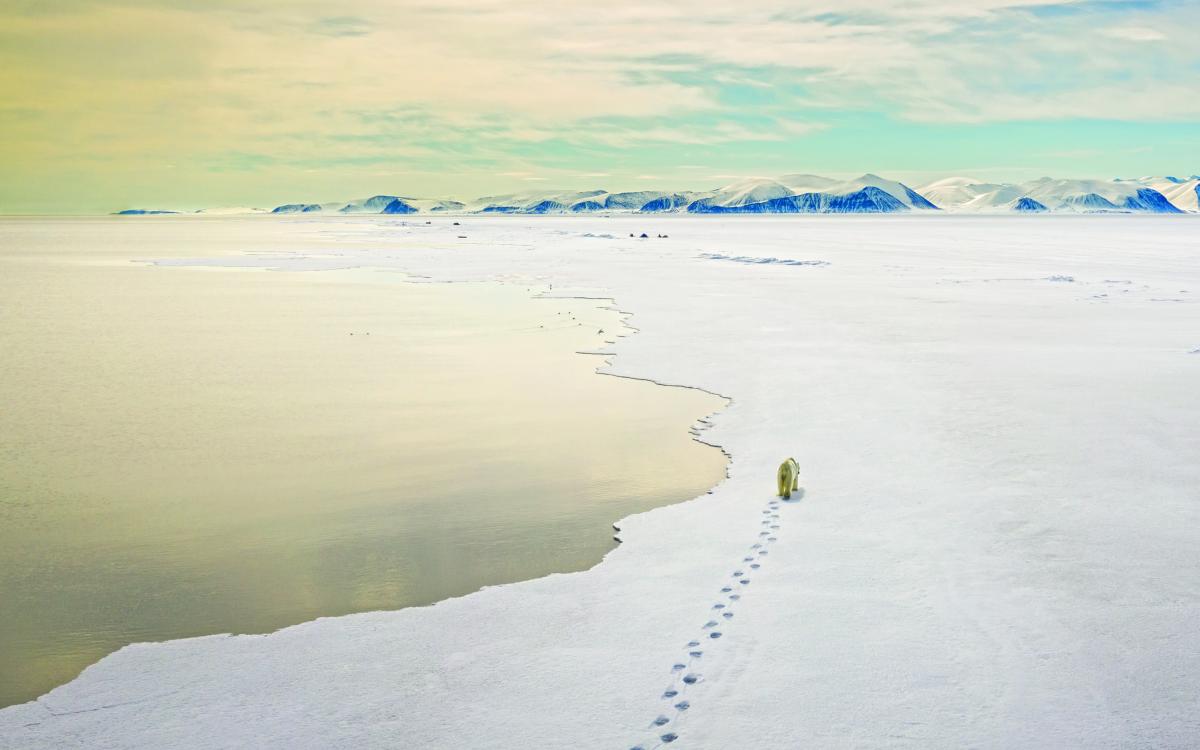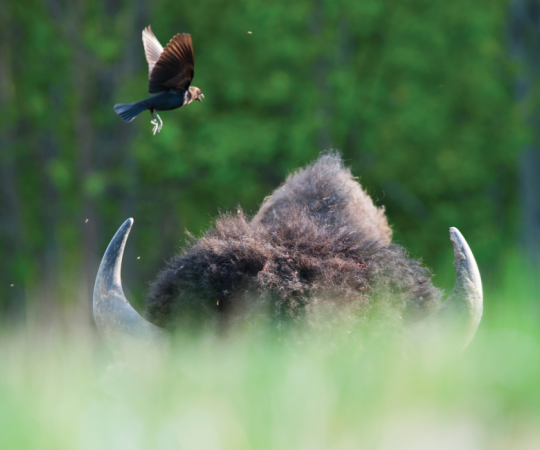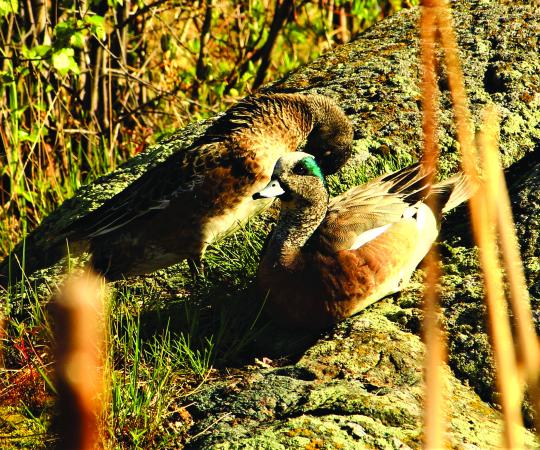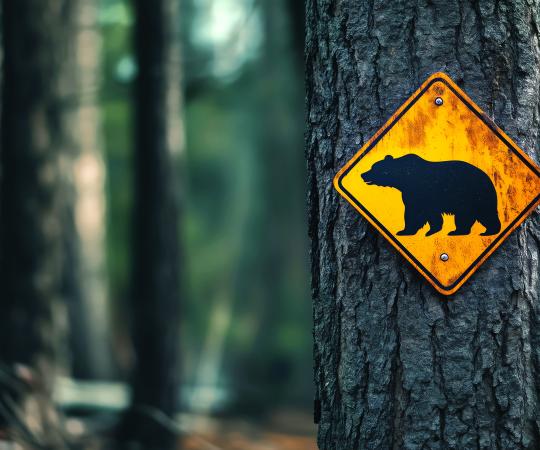EVAN RICHARDSON watched from the helicopter as it flew over frozen inlets where the ringed seals rear their pups. He was part of a team conducting a polar bear survey north of Wynniatt Bay on Victoria Island on a -25°C morning in April 2012.
“What is that?” one of his colleagues exclaimed over his radio headset.
Richardson looked out a rear window and was surprised to see a large grizzly bear chasing a small polar bear across the sea ice. This region on the western edge of the Northwest Passage is home to one of the world’s 20 polar bear populations. Historically, grizzlies had been documented along the coast of NWT and the Yukon North Slope, a vast coastal plain that’s vital to the Inuvialuit for harvesting. But they were less common further north in the Arctic Archipelago, including Victoria Island and Banks Island. Since the early 2000s, though, sightings of them by the Inuvialuit and scientists were on the rise.
As the helicopter swung around for a closer look, the polar bear clambered up a rocky slope, leaving the grizzly down below. Steam rose off their backs from the intensity of the chase. The polar bear turned to look at the researchers. It had a dark stripe down its back, strange footpads and what Richardson thought of as “Coke-bottle eyes” because they were ringed in dark fur. The animal certainly didn’t look like a polar bear, but nor did it look like a grizzly. Richardson, a scientist with Environment and Climate Change Canada, wondered if it was a hybrid, a cross between the two species.
Scientists weren’t sure how many hybrids—considered incredibly rare—existed or if their offspring could even reproduce. At least two had been harvested by Inuvialuit hunters since the mid-2000s. Southerners call them grolars or pizzlies, but the Inuvialuit in Ulukhaktok on Victoria Island prefer nanugluq or akhaq-nanuq. Richardson and others in the scientific community opt for hybrid.
Despite their excitement, Richardson’s team didn’t have a permit to handle a hybrid, so they recorded the GPS location and returned the following day—without any luck. The bears had vanished against the windswept plateau of snow and ice. Only a day later, though, flying north of Wynniatt Bay, the researchers spotted what turned out to be an adult male grizzly bear, likely the same one they’d seen chasing the hybrid, ambling alone across the sea ice. They landed to draw a DNA sample.
What was this terrestrial bear doing out in the middle of the sea ice? It was a mystery that would intrigue Richardson for years. There were no muskox or caribou in sight, and it would be weeks before spring green-up. He wondered if the grizzly had traveled past the boundaries of his range in pursuit of mating with polar bears or perhaps the potential hybrid. If the latter was true, then it could imply significant cross-species ecological changes. The peculiar encounter with the bear with Coke-bottle eyes would haunt him for years to come, as he and his colleagues tried to piece together what was underway in the western Arctic.
ANDREW DEROCHER, a bear biologist at the University of Alberta, was hunkered down in a hunter’s cabin in April 2006 when the call came over the bush radio for his guide, Tony Green. Roger Kuptana, an Inuvialuit guide, told him that a trophy hunter from Idaho had shot a “funny-looking polar bear” near Sachs Harbour.
Kuptana suspected it was a cross between two ursine species. “He didn’t need genetics to tell him what he was looking at,” Derocher says. A few weeks later, DNA analysis confirmed the Sachs Harbour animal was 50 per cent polar bear and 50 per cent grizzly—making it the world’s first hybrid documented in the wild.
Scientists knew it was possible. Several European zoos had already experimented with breeding polar bears and grizzlies in captivity. For a decade, Tips and Taps, two cappuccino-coloured hybrid siblings lived at a German zoo until 2017, when Tips broke out of her enclosure and had to be euthanized. More significantly, there are historic examples of the two species genetically crossing over in the wild where their habitats meet. “Polar bears and grizzly bears have always overlapped on the edges,”
Derocher says. He points to recent genetic studies of the “ABC bears,” a subspecies of brown bear, or grizzly, found on the Admiralty, Baranof and Chichagof islands in southeastern Alaska. They look like grizzlies, but their genomes contain up to 8.8 per cent polar bear ancestry. The DNA mix could stem from when female polar bears, stranded on the islands at the end of the last ice age, mated with male grizzlies who’d swum over from mainland Alaska.
Biologists call this “male dispersal bias.” When a population reaches the limit the environment can support, male bears can travel long distances to stake out home ranges. It could be, in part, what’s driving the expansion of grizzlies across Canada’s Arctic regions today. The other factor is a warming climate that’s extending the active season for grizzly bears in the Arctic, resulting in a smorgasbord for a species that’s built “like a garburator,” according to Derocher. Grizzlies feed on vegetation, goose eggs, sik-sik (arctic ground squirrels), caribou, muskox and moose. “They’ll eat just about anything.”
They may be adapting to life on the sea ice, too. Since the early 2000s, Inuvialuit have seen several grizzlies hunting for seals on the ice, according to a 2015 traditional-knowledge study. On a foggy day, a Tuktoyaktuk hunter was tracking what he thought was a polar bear. “When it cleared up, it was a grizzly bear,” he told researchers. The sound of his snowmobile scared the grizzly away. “I see where it get them pups though, got them pup seals, pulled them out.”
For some polar bear populations—a species hard-wired to ice, specialized to subsist on seal blubber—a warming climate and an increasing number of days on shore, fasting, mean an uncertain ecological future. As one bear species expands in the Arctic while another shrinks, their two worlds will collide. Some scientists have speculated polar bears could be genetically “absorbed” by grizzly bear DNA (as happened with the ABC bears). But, until 2014, no one had proof that hybrid offspring could even reproduce.

A POLAR BEAR scientist since 2000, Richardson lives in Winnipeg with his wife and children. But he’s frequently on the move collecting data on Canada’s 13 polar bear populations. In April 2014, two years after witnessing the grizzly chase the mysterious hybrid, he was back in Wynniatt Bay. Flying over the frozen landscape, the biologist and his colleagues spotted a mocha-coloured bear trailed by three chocolate-brown cubs running across the sea ice. Richardson had no doubt about it: hybrids.
As the chopper flew closer, he recognized the stripe on the bear’s back and the dark rings around her eyes. He was almost certain she was the hybrid they’d spotted in 2012. From the helicopter, the scientists darted the mother bear with a tranquilizer gun and landed to safely capture the cubs and extract DNA samples from the family. It was the first and only live capture of a hybrid in the circumpolar Arctic. Richardson was elated. Bear 15718, as he and his team called her, had helped solve part of the mystery: hybrid offspring could, indeed, produce cubs of their own.
Studying her physiology up close remains one of the most fascinating moments of Richardson’s career. Polar bears have furry footpads that help them grip ice and for warmth, while grizzlies have a leathery footpad without hair. But the hybrid’s feet were, he says, a “weird mix between the two.” Polar bears possess short, hooked claws—“almost like a cat”—for grabbing slippery seals and other marine prey; grizzly claws are long, more adept at digging for roots. The hybrid’s claws were somewhere in between. Grizzlies have flat molars for grinding up vegetation; polar bears tend to be sharper for shearing flesh and frozen blubber, but hers weren’t specialized for either.
With physiological traits less suited to life out on the ice, it couldn’t have been easy for Bear 15718, who lived like a polar bear and was raising her three brown cubs that way. Imagine her trying to camouflage herself against the ice while sneaking up on a ringed seal. But somehow, she was doing it. Based on her teeth, she was 11 years old. And the DNA analysis confirmed she was a first-generation hybrid who’d mated with a grizzly. Her cubs, second-generation hybrids, were 25 per cent polar bear and 75 per cent grizzly.
One cub had a cream-coloured chest patch, but other than that, they didn’t have any other physical features to indicate their mixed DNA. If Richardson hadn’t seen their mocha-coloured mother, he’d have assumed they were grizzly bears. That made him wonder how many hybrids were out there.
Hoping to learn how she was teaching her second-generation cubs to live out on the sea ice, the researchers put a GPS-tracking collar on Bear 15718. But after a few days—as grizzlies are prone to do—she clawed it off.
RICHARDSON and his colleagues turned to DNA analysis to map out a family tree of hybrids. They wanted to better understand how many individuals of the two species had actually mated—and just how prevalent the phenomenon of hybridization was in the region.
They cracked part of the code in 2017. A genetic study led by biologist Jodie Pongracz and published in Arctic journal, identified eight hybrids on Victoria Island. Intriguingly, all could be traced back to the same matriarch, a polar bear born in 1986 who mated with two different male grizzlies—including the one Richardson handled in 2012. Bear 10960 produced four first-generation hybrids, including the mocha-coloured one with the Coke-bottle eyes. These four offspring gave birth to four second-generation bears.
Seven years later, researchers developed a genomic tool called the Ursus maritimus V2 SNP chip to analyze DNA samples collected from 800 polar bears, grizzlies and known hybrids in Canada, Alaska and Greenland between 1975 and 2015. Richardson and his colleagues searched the samples for “fingerprints of hybridization,” tracing three generations back. The study didn’t identify any hybrids beyond the known eight, leading the scientists to believe Bear 10960’s family was a relatively new and isolated phenomenon.
So why did this matriarch opt for a male grizzly over a polar bear? Females are choosy. They won’t mate with just any male who’s hanging around. They make their mating choices based on age and size and to maximize reproductive success. Which makes Bear 10960’s dating history even more curious. Was there something about those grizzlies that prompted her to “swipe right”? Was the recent hybridization all a matter of one individual’s bear unusual choices? Maybe.
But even so, just because the story of hybrids in the western Arctic boils down to one bear and her atypical mating preferences doesn’t make it any less significant for what could come. If it happened once, it could happen again.

WHILE MANY SCIENTISTS, including Richardson and Derocher, agree that hybridization doesn’t pose an ecological threat to polar bear conservation in the western Arctic—not yet anyway—there are far greater implications concerning human-bear coexistence and what hybrids mean to Inuvialuit communities in the Arctic Archipelago.
Douglas Clark first traveled to Ulukhaktok to meet with the hunters and trappers committee in 2019. A human-bear conflict specialist at the University of Saskatchewan, he wanted to learn about the challenges of coexisting with polar bears.
But no one wanted to talk about that. “We’re good with polar bears,” they told him. They wanted to talk about grizzlies, a species they joked, “Came for the caribou and stayed for the muskox.”
Grizzlies have probably been around the Arctic Archipelago for longer than western science realizes, Clark says. One of the earliest Inuvialuit sightings of a grizzly on Banks Island dates back to 1949–50, according to the 2015 traditional-knowledge study.
Lately, the Inuvialuit have reported seeing grizzly bears killing muskox or fighting with—and even preying on—polar bears. They frequently described the former as “aggressive” and the latter as more “laid-back.”
But people in Ulukhaktok also spoke openly about hybrids, and Clark now says, “They’re just a third kind of bear up there.”
One hunter told him that when hybrids catch a seal on the ice, they eat the brains and leave the carcass—a behaviour that’s common with grizzlies feeding along salmon-bearing rivers. Since hybrids behave differently than either parent species, people are wary of their unpredictability.
They’re worried about personal safety and property, but also about traditional subsistence practices. Last summer, David Kuptana, an Inuvialuit hunter from Ulukhaktok, told CBC News that his community is seeing an increase in grizzly tracks when they go out hunting. He’s concerned what the increased presence of both grizzlies and hybrids will mean for caribou.
ONE MYSTERY remains for Evan Richardson: are there any hybrids still out there?
Hunters have harvested the original female polar bear and her three first-generation offspring, but no one knows the whereabouts of Bear 15718, the hybrid with Coke-bottle eyes. Today, she would be 22 years old and likely nearing the end of her life.
Scientists are unsure if her second-generation cubs survived or reproduced young of their own. Nor do they know if she produced more offspring or if more polar bears are mating with male grizzlies in the western Arctic.
Given the historical context of hybridization, there’s always a possibility it could happen again or occur elsewhere in the Arctic where polar bear and grizzly habitats overlap. “With climate change and shifting range distribution of species, and all the variability we see in everything,” Richardson says, “not a lot surprises me anymore.”









